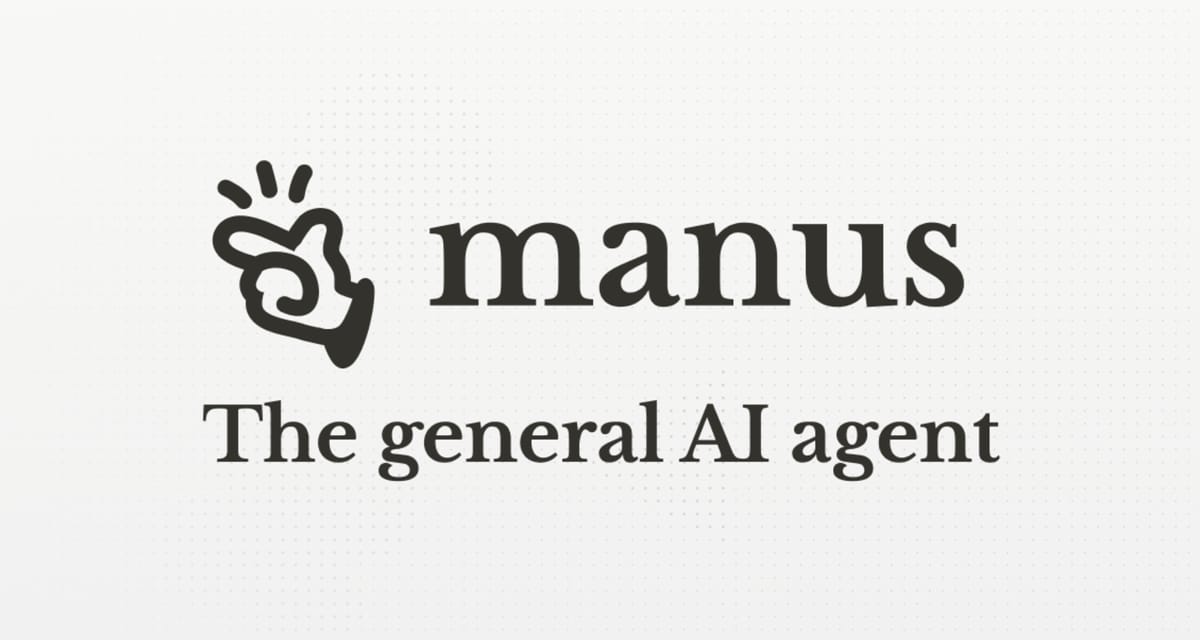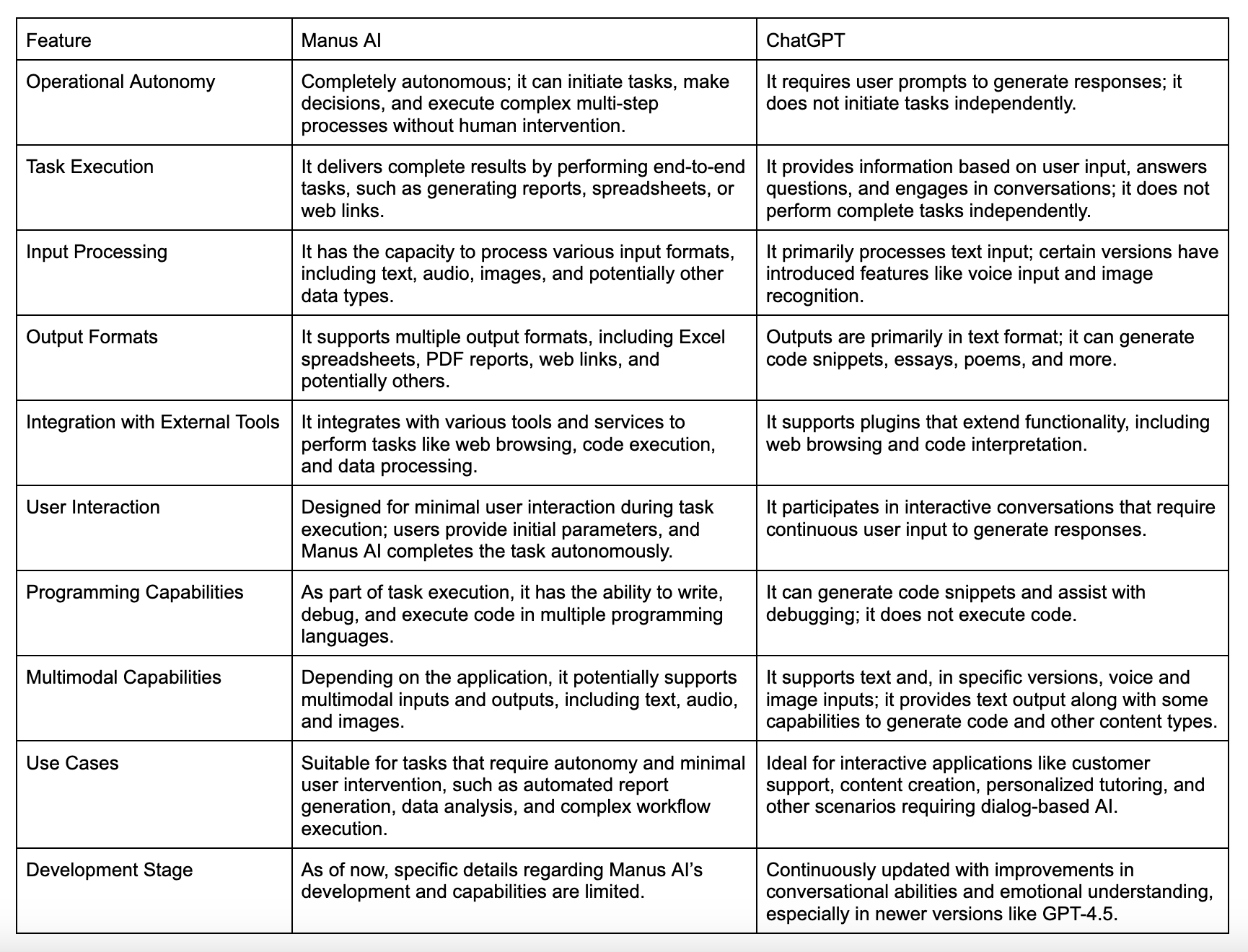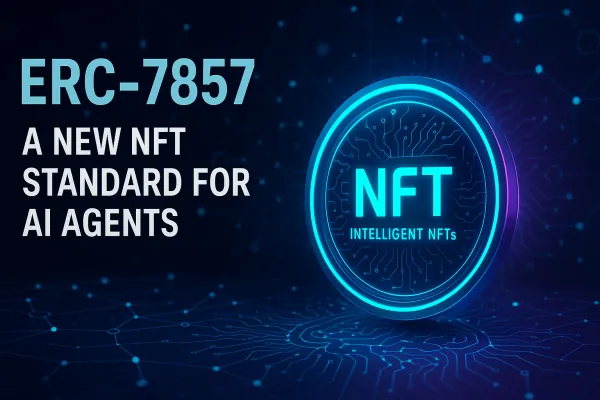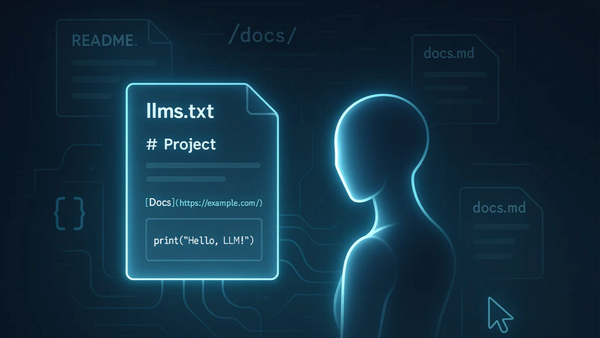Manus AI: The Dawn of Autonomous AI

What is Manus AI?
Manus AI is an autonomous general AI agent capable of performing complex, real-world, multi-step tasks with minimal human input. Unlike traditional AI models that passively wait for user prompts and respond reactively, Manus can independently plan, execute, and refine tasks. What sets Manus apart is its ability to generate outputs beyond simple text responses—it can produce PowerPoint presentations, process various document formats, and even handle packaged mobile applications, something ChatGPT cannot achieve.
Developed by the China-based startup Monica, Manus was officially announced on March 5, 2025, via the social network X. The company’s founder, Xiao Hong, is a serial entrepreneur and a graduate of Huazhong University of Science and Technology in Wuhan.
Following its announcement, many in the media have referred to Manus as the second “DeepSeek Moment.” What makes Manus unique is its adoption of a “multi-model dynamic invocation” strategy, which allows it to flexibly call upon different advanced AI models—such as GPT-4, Claude 3, and Gemini—based on specific task requirements. For instance, if logical reasoning is needed, Manus can invoke Claude 3; if programming capabilities are required, it can use GPT-4; and for information synthesis, it can leverage Gemini. By integrating and synthesizing the strengths of multiple AI models, Manus delivers a more accurate, powerful, and versatile AI experience.
How Does Manus AI Work?
Manus AI is an autonomous multi-agent system designed to handle complex, multi-step tasks with minimal human intervention. Unlike conventional AI chatbots that rely on continuous prompts and reactive responses, Manus AI independently analyzes, plans, executes, and validates its tasks, ensuring high-quality outputs across various domains.
At the core of Manus AI’s functionality is a structured execution loop that dynamically adapts to different task requirements. Rather than treating a task as a single action, the system decomposes it into structured sub-tasks, first analyzing the request to determine the objective, necessary steps, and dependencies before proceeding with execution. This structured approach enables it to manage complex workflows that involve decision-making, iterative refinements, and automation.
A key differentiator of Manus AI is its ability to leverage multiple AI models through a dynamic invocation strategy. Instead of relying on a single large language model, it intelligently selects the most suitable model based on the nature of the task. For reasoning-intensive processes, it employs Claude 3.5 Sonnet; for code generation and execution, GPT-4; and for information synthesis and data retrieval, Gemini. This multi-model strategy ensures optimal performance by combining the strengths of different models to deliver precise and efficient results.
Once the appropriate model is selected, Manus AI executes tasks within a controlled Linux-based sandbox. This secure environment allows it to retrieve real-time data and validate factual accuracy, process both structured and unstructured data—including large datasets—and autonomously write, test, and deploy code. It also enables Manus to automate web interactions, such as form filling, web scraping, and API calls, further expanding its range of capabilities.
Manus AI follows a modular execution flow, meaning it does not rely on rigid scripts but dynamically adapts its operations based on feedback and task progression. Unlike static AI systems that generate outputs without post-processing validation, Manus AI incorporates a built-in self-correction mechanism. If inconsistencies or errors arise, it re-evaluates the execution steps, automatically refines its approach, and re-runs necessary computations to ensure accurate, reliable, and optimized results.
Beyond its autonomous execution, Manus AI seamlessly integrates with third-party tools and environments, allowing it to interact with web browsers for automated data retrieval, code editors for software development and debugging, and data visualization platforms for structured reporting. This broad integration capability makes it a powerful tool for tasks ranging from financial analysis and market research to software development and workflow automation.
One of Manus AI’s most powerful features is its asynchronous operation, which enables users to delegate tasks and step away while the system completes them autonomously. Its cloud-powered execution framework ensures that long-running tasks continue in the background without requiring user intervention. Results are synced in real-time and available upon completion in various formats, including structured reports, dashboards, or executable scripts.
Over time, Manus AI continuously improves its efficiency by learning from past tasks and adapting to user preferences. Its ability to dynamically interact with external environments further enhances its adaptability, making it suitable for a wide range of applications.
With its advanced architecture and autonomous execution capabilities, Manus AI moves beyond traditional chatbot interactions, offering a fully functional AI-driven automation experience.
Use Cases for Manus AI
Business & Marketing
Recruitment and talent management can be significantly enhanced by efficiently parsing candidate resumes and filtering the most suitable talents for specific job positions. By leveraging structured evaluation methods, you can ensure that hiring decisions are made based on relevant qualifications, skills, and experience, leading to a more effective and streamlined recruitment process.
In addition, optimizing the interview process can greatly improve hiring and management efficiency. By assisting in the creation of structured interview templates, you can standardize evaluation criteria, making it easier to compare candidates objectively. This approach not only enhances the consistency of the hiring process but also helps managers make more informed decisions when selecting new team members.
For businesses looking to stay ahead in a competitive market, conducting thorough market analysis and competitive research is essential. You can examine current market trends, track industry developments, and analyze competitors to develop data-driven strategies that strengthen business positioning. By identifying key opportunities and potential threats, businesses can make more strategic decisions that drive growth and long-term success.
In the digital sphere, SEO and website optimization play a crucial role in increasing online visibility and attracting more traffic. By analyzing website performance metrics and generating detailed SEO optimization reports, you can identify areas for improvement, refine content strategies, and enhance search engine rankings. This ensures that businesses can reach their target audience more effectively and maintain a strong online presence.
Supply chain management is another area where efficiency and strategic decision-making are vital. By assisting in B2B supplier sourcing, you can help businesses identify, filter, and select the most suitable suppliers based on factors such as cost, reliability, and quality. This approach optimizes procurement processes, reduces operational risks, and enhances overall efficiency, ensuring that supply chain operations run smoothly and effectively.
By integrating these strategies, businesses can optimize their operations, improve decision-making processes, and maintain a competitive edge in their respective industries.
Personal Assistant & Productivity
Personalized document creation can be streamlined by automatically generating professional business cards based on individual profiles or resumes. This ensures that each card is tailored to the user’s background and professional identity, enhancing personal branding and networking opportunities.
Travel planning can also be optimized by developing detailed itineraries that include scheduling, transportation, accommodation, and sightseeing recommendations. By providing a well-structured plan, users can enjoy a seamless travel experience with minimal effort in organizing logistics.
For mental well-being and meditation, customized audio meditation sessions can be created to help users relax, improve focus, and reduce stress. These personalized sessions can cater to individual preferences and needs, promoting mindfulness and overall mental health.
By integrating these capabilities, users can benefit from automation in document creation, travel planning, and mental well-being, making daily tasks more efficient and enhancing their overall experience.
Data Analysis & Intelligence
Financial and investment analysis can be enhanced by conducting in-depth stock evaluations, designing interactive data visualization dashboards, and providing comprehensive investment insights. By leveraging data-driven approaches, you can identify market trends, assess financial risks, and develop informed investment strategies that align with financial goals.
Corporate financial reports can be analyzed to offer data-driven business decision recommendations. By evaluating key financial indicators, profitability metrics, and operational performance, businesses can gain valuable insights to optimize financial planning and improve long-term sustainability.
Consumer and retail analytics can be utilized to study community consumption trends and develop effective retail sales optimization strategies. By analyzing purchasing behaviors and demand patterns, businesses can refine product offerings, enhance customer experiences, and maximize revenue potential.
Social media sentiment analysis enables brands to monitor discussions and emerging trends by tracking and evaluating user sentiment across various platforms. By understanding public perception and engagement, businesses can adapt their marketing strategies, manage brand reputation, and respond effectively to customer feedback.
Traffic and market data research can be conducted to analyze mobile internet traffic, demographic trends, and social media behaviors. By interpreting these insights, businesses can tailor their advertising strategies, identify target audiences, and optimize digital marketing efforts to drive growth and engagement.
By integrating these analytical capabilities, organizations can make more informed financial decisions, enhance customer engagement, and refine market strategies, ensuring sustained business success.
Content Creation & Education
Speech transcription and documentation can be enhanced by converting audio content into structured, visually enriched text records. This transformation ensures clarity, accessibility, and ease of reference, making it valuable for meetings, interviews, lectures, and other spoken content that requires accurate documentation.
Information management and learning resource organization can be optimized by intelligently collecting and structuring study materials to improve productivity. By categorizing and indexing educational content, learners and professionals can quickly access relevant information, streamline research efforts, and enhance knowledge retention.
Educational resource development can be further improved by creating interactive courses and video presentations designed to enhance teaching effectiveness. These resources provide engaging learning experiences, support diverse teaching methods, and enable educators to deliver complex concepts in an accessible and visually appealing manner.
By integrating these capabilities, users can benefit from enhanced documentation, efficient knowledge management, and high-quality educational materials, ultimately fostering better learning outcomes and streamlined workflows.
Research & Information Retrieval
Industry research and product analysis can be conducted to support market assessments and sector-specific evaluations in industries such as cosmetics, fashion, and artificial intelligence technology. By analyzing market trends, consumer preferences, and competitive landscapes, businesses can make data-driven decisions to enhance product positioning and innovation strategies.
Policy and social research can be improved by analyzing U.S. artificial intelligence policies from the past decade and examining public opinions on specific events. This approach provides valuable insights into regulatory trends, societal concerns, and the evolving role of AI in governance and ethics.
Business and market intelligence can be leveraged to conduct market valuation research and competitor analysis, aiding in strategic business planning. By assessing industry performance, identifying emerging opportunities, and evaluating competitor strategies, organizations can refine their market approach and strengthen their competitive edge.
By integrating these research capabilities, businesses and policymakers can gain a deeper understanding of industry dynamics, regulatory landscapes, and competitive markets, ensuring well-informed decision-making and strategic growth.
Benchmarks and Competitive Analysis
GAIA (General AI Assistants) is a metric designed to evaluate the capabilities of general artificial intelligence assistants in overcoming real-world challenges. It was proposed in 2023 by Meta AI (FAIR), Hugging Face, and other research teams. The metric is divided into three levels—Lv.1, Lv.2, and Lv.3—based on increasing difficulty. The GAIA metric evaluates an AI’s proficiency in web searching, tool usage, coding, file processing, and multimodal reasoning. Manus AI is reported to have achieved state-of-the-art (SOTA) performance, surpassing leading AI models, including OpenAI’s GPT-4, in the GAIA benchmark.
Manus vs ChatGPT

Conclusion
Manus AI represents a significant leap in the evolution of artificial intelligence. By combining autonomous task execution, multi-model dynamic invocation, and integration with various external tools, Manus AI offers a level of functionality and versatility that sets it apart from traditional AI systems like ChatGPT. Its ability to independently plan, execute, and refine complex, multi-step processes with minimal human intervention makes it a powerful tool for businesses, personal productivity, data analysis, and more.
Unlike traditional AI models that rely on user inputs for each interaction, Manus AI’s operational autonomy enables it to handle end-to-end tasks, transforming workflows, automating business processes, and significantly enhancing decision-making capabilities across various industries. The integration of multiple AI models like Claude 3, GPT-4, and Gemini ensures that Manus AI can select the best model for the task at hand, leading to more accurate and efficient results.
Whether it’s generating reports, optimizing workflows, assisting with recruitment, or analyzing market trends, Manus AI’s diverse capabilities provide an unprecedented level of flexibility and utility. As it continues to evolve, Manus AI has the potential to redefine how we interact with artificial intelligence, paving the way for a future where autonomous AI systems take on more complex, real-world challenges with minimal human oversight.
In a world where efficiency and precision are paramount, Manus AI stands at the forefront, revolutionizing the way AI is utilized across industries and setting new benchmarks for intelligent automation.
Interested in AI agents? Try Vexom AI!
Vexom AI is your gateway to an effortless blockchain experience, powered by advanced AI agents designed for simplicity and security. Whether you're exploring DeFi, NFTs, staking, or token management, Vexom AI allows you to interact seamlessly using simple, natural language commands. No prior blockchain knowledge required—just say what you need, and let our intelligent agents handle the rest. Experience the future of blockchain interactions with Vexom AI today! Explore: Vexom AI





